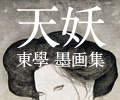手招きする妖艶、昇華しきれぬ妖気
東 學 公式サイト『天妖』
大阪ミナミ在住の絵師・東 學 (GAKU AZUMA)に関するニュースをお届けします。
【PROFILE】 絵師・東 學の人と成り
最新情報(188ニュースより)
東 學 (gaku azuma)
絵師・アートディレクター / 株式会社 一八八 所属
京都生まれ、墨絵師。日本の演劇・舞台シーンにおいて数多なるポスターデザインを手がけてきた異端的アートディレクター。雪駄に作務衣という独特の風貌で大阪ミナミに棲息。「平成の浮世絵師」と呼ばれる。 扇絵師であった父・東 笙蒼のもと幼い頃から絵筆に親しむ。14才から3年間、米国留学。当時の作品『フランス人形』はニューヨークのメトロポリタン美術館に永久保存されている。
テーマは一貫して「女」。その純日本的な血から生み出される「墨画(bokuga)」には、アートディレクターとして名を馳せる彼のアバンギャルドな感性と、日本古来の美意識の両方が凝縮されている。
東の編み出した「墨画(bokuga)」には、伝統的な水墨画などに見られる“ぼかし”などの墨の濃淡がない。黒髪も、柔肌の丸みも、着物の柄として描かれた様々な花や生きものたちの表情もすべて、極細い筆先から生まれる「線」だけで表現されている。また、墨以外の色も排除してあるのに、絵の女たちは、鮮烈な色彩感覚を呼び起こし、手ざわり、匂いまで感じさせる。
2003年、ニューヨーク『MEGU』装飾画として、遊女二十体を描いたのを皮切りに数多くのファンが生まれ、2007年には初の墨画集『天妖』(PARCO出版)を刊行。現在、日本を拠点に年2~3回のペースで展覧会を開く。
Gaku Azuma
“UKIYOE”Painter/Art director of the 188 Corporation, Osaka
Gaku Azuma was born in 1963 in Kyoto, Japan to the ougi-e (Japanese traditional painting on paper fans) artist, Shoso Azuma. His artistic talents developed from a young age spending time with his father in one of Japan’s most cultural city, Kyoto. He later moved to the United States from the age of 14 for educational purpose and ended up staying there for three years. During that period, he painted a piece called “The French Doll” which is now permanently housed in the Metropolitan Museum of Art in New York.
Despite of his successful carrier as an art director for the theatrical advertisement industry, he has been actively exhibiting his own art works, Bokuga, internationally and received the Osaka Mayor’s Award in 2007 with “The Bride of Frankenstein”. In the same year, his paintings, “The Long Neck,” and “Hundred Eyes,” were featured in the magazine, “Kokoku Hihyo,” and his first book of paintings, “Tenyo” was published by Parco Publishers.
Bokuga is a painting style he originated which has similarities to Suibokuga. The technique used for Bokuga requires the painter to make a beautiful gradation of the sumi-ink by applying numerous sensitive brush strokes, instead of just blurring the ink, as in the Suibokuga style.
His main theme is women or feminine energy in which he succeeded in depicting by taking away their individual aspects. Their sensual faces without eyebrows do not reveal nationality or age. The only aspect by which a woman is distinctive is by the design of kimono she wears. In contrast to the uniformity of the women, each of their kimonos appears vivid, ferocious, and fearsome. By wearing the kimono, each woman comes into existence by possessing a unique personality.






